“Con mortuis in lingua mortua.”
—Modeste Mussorgsky
Blood seeps through the gauze on Salima’s foot. It’s what we notice first: the dark, rusty seepage a sharp contrast to the pastels of her pajamas and room. She’s thirteen, we learn, but the distant look in her eyes belongs to someone much older. She sits squat on the bed, chin resting on her knee. She seems mindless of her burns. Her mother and sister also survived, but three others in her family were killed when the American helicopter opened fire on their tent in Kandahar.
A few paces on, a boy stares at us wide-eyed. Americans in jeans, in coats and scarves, a funny wide-brimmed hat. What might he imagine of us and the distant and wealthy place from which we come? Maybe we have candy. His eyes are wide and blue. He leans on a walker, struggling with his new prosthetic leg. Behind him, stacked like so many rakes and shovels in a Home Depot display rack, stand rows of prosthetic limbs. One renegade leg with a shoe on its foot dangles from the shelf as if about to walk out of the painting on its own.
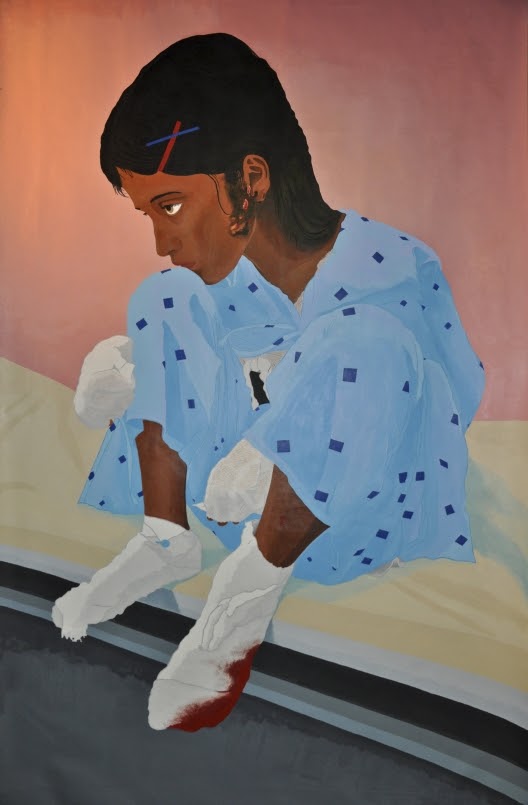
“Salema” by Nanna Tanier; image from the American Friends Service Committee (AFSC) Windows and Mirrors website (site no longer available).
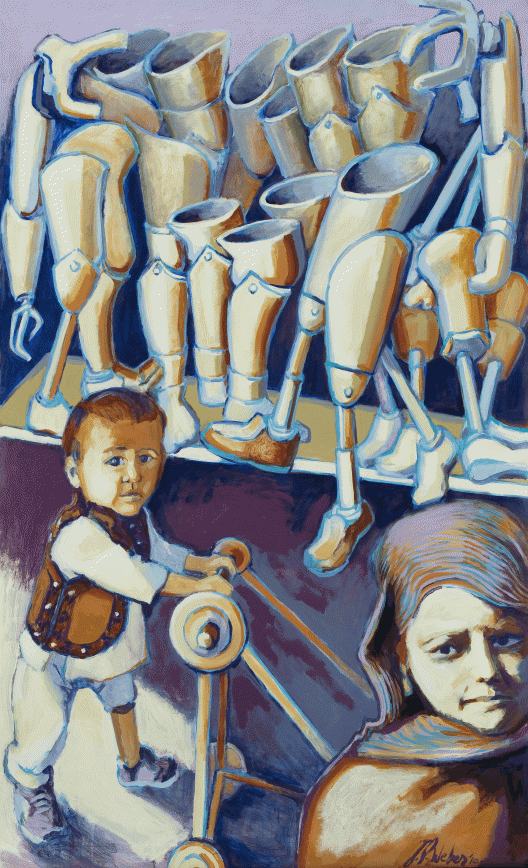
“Learning to Walk Again” by John Pitman Weber; image from the AFSC Windows and Mirrors website (site no longer available).
Murals tend toward bluntness. Images are large, broadly depicted, thick with meaning. They may have subtleties, but they are rarely subtle. The nature of the medium—from the Latin word murus, wall—invites simplicity and directness. City streets and alleys, interiors and exteriors of buildings become canvas. This isn’t art created in a studio and then set outdoors, like a bronze statue in a city park. The setting, the place it resides is integral to its nature and creation. The audience is not museum visitors, but passers-by, and those who live with it. Murals may be illegal, even offensive, and impossible to ignore. Such artwork becomes an element of the life of a neighborhood, for better or worse, a landmark, a defining characteristic, a part of the community. One may choose to go to a museum. Or not. But a mural on the side of a building confronts the viewer; it demands a response.
Early twentieth century muralists, from Northern Ireland to Spain to Mexico, all of which experienced vast political upheavals in those decades, are often credited with transforming this ancient art form into a socially- and politically-charged medium. They not only recognized the power of its visibility, but in regions where illiteracy was common, it was both an effective means of communication and also offered the oppressed a sense of unity. Mexico produced some of the most influential muralists of the twentieth century. Known as Los Tres Grandes, José Clemente Orozco, Diego Rivera, and David Alfaro Siqueiros1 were political activists and artists. Their work spoke for the poor, the oppressed; for revolutionaries and peasants. Art with a social purpose, art for those who could not go to museums and for whom museum art did not speak. These muralists rejected the notion that art is the provenance of wealth and privilege.
Such is the context for Windows and Mirrors: Reflections on the War in Afghanistan, an exhibit of mural-styled paintings that toured the United States and Canada in 2011-12. Sponsored by the American Friends Service Committee (AFSC), a Quaker organization, this exhibit gathered works by forty-five artists, as well as drawings by school children from around the world, into what the catalogue describes as “a traveling memorial to Afghan civilians who have died in the war.” Stylistically, these paintings offer a vibrant connection to the mural tradition: painted (or assembled, for several are collages) in broad strokes with graffiti-like imagery, and highly accessible in meaning, symbol, and representation. Muralist John Pitman Weber, whose painting Learning to Walk Again I referenced above, is a co-founder of the Chicago Public Art Group and one of the project’s organizers. The mural tradition, Weber said in a New York Times interview, had become increasingly “domesticated and institutionalized.” He wanted Windows and Mirrors to be unapologetically political in giving voice to the civilian victims of America’s longest war.2
And its most invisible. In late 2011, when my wife Heather and I toured this exhibit at the Kansas City Public Library, it had been ten years since the invasion of Afghanistan, which began as the hunt for Osama bin Laden and then slogged through as many reasons for waging war there, it often seemed, as seasons that passed in all those years. In an untitled panel, artist Jessica Munguia pasted the war’s evolving mission statements into a collage of weaponry and military-speak, alongside images of an Afghan woman and child weeping. There has been no Life Magazine moment for this war, as there was over forty years earlier, when a black-and-white photo of a terrified, naked child running from the horror of napalm became the emblem of America’s war in Southeast Asia. And unlike the invasion of Iraq, which by 2005/6/7 many Americans had begun to realize was both a mistake and a disaster, Afghanistan was still, ten years later, as we stood before these panels, regarded by many as a “just war” and its civilian victims little more than regrettable and faceless casualties, “collateral damage” (also the title of a painting in the exhibit) in the virtuous cause of “keeping America safe”—the go-to meme of American politicos who want to keep their jobs and government healthcare.
*
Kansas City’s empty downtown streets echo with our footfalls in the grey barrenness of a cold Sunday afternoon that we find oddly welcoming. Busy sidewalks and bright sunlight wouldn’t have felt right. We are still new to grief. We’d lost our son Francis just ten months earlier. His Afghanistan deployment in 2006-7 had awakened us to this war’s true victims. In the cavernous quiet of the Kansas City Library, where the display of Windows and Mirrors meanders through a gallery and adjacent hallways, we find a connection both to them and to him. These paintings complement our inner turmoil in ways that are at once soothing and enlivening. Grief is not something the grieving wish to abandon or suppress. Just the opposite—it rather seeks to be fully experienced until it’s ready to cohabitate with other moods and sensibilities. Navigating even the simplest markers of life—meals, holidays, a trip to the grocery store, the changing seasons—often feels like walking a cliffside path in thick fog. Unseen objects provoke spasms of fear and sorrow and tears. We grapple with the nagging sense that our son’s death is an event, a happening, a circumstance we just need to “figure out,” as Heather puts it, as if we can negotiate or reason with it; as if, like many problems parents face, once understood, we can fix it.
As the title suggests, Windows and Mirrors is at once a gallery of windows into an Afghanistan few Americans, including us, will ever see and a hall of mirrors reflecting who we are in the bitter reality of our presence there. For the artist, philosopher Theodor W. Adorno writes, the “unsolved antagonisms of reality return in artwork as immanent problems of form.”3 Windows and Mirrors resolves—or synthesizes—these antagonisms in the conceit of murals now rendered on stretched parachute cloth (itself a suggestive medium in the context of this war) with identical dimensions, four feet wide by six feet in height, and hung museum-like in a way that would seem contrary to the mural tradition from which they’re derived. This uniformity, also a kind of contradiction, further synthesizes the conceit, as the exhibit hints at allegorical settings that might range from the symmetrical fenestration of the Windows on the World restaurant in the North Tower at the World Trade Center, overlooking the city and beyond, to a country church whose windows are populated by saints canonized through their own suffering. The gallery itself, through the uniformity of the panels’ dimensions, becomes a many-windowed room that looks out on scenes of a war that terrorizes the most vulnerable of the Afghan people. The exhibit effectively becomes a single work of art, just as trees in an aspen grove are part of a single organism that spreads itself across a mountainside.
Heather and I find ourselves looking through these windows onto the world that changed our son—and us. Afghanistan was his second overseas tour. The first had been to Iraq. An infantryman in the Army’s 10th Mountain Division, he was inevitably going to be sent where the fighting was worst—and sent there in each war during the worst of the fighting. He’d seen friends die and suffer terrible injuries in Iraq, and many civilians, too. He’d killed men there, and become cynical. Children to whom he’d once thrown candy might be concealing weapons or acting as lookouts. “Don’t send more candy,” he wrote. He was a stalk when he returned, pale, gaunt, drained not only from the physical demands of his thirteen months in Iraq, but from moral injuries, from living in humanity’s writhing underbelly. When he deployed to Iraq in 2003-4, we’d all naively thought Afghanistan wouldn’t have been as awful. We couldn’t have been more wrong.
When his company was later sent to eastern Afghanistan, along the mountainous border with Pakistan, a stop-loss extension—the backdoor draft of these wars—kept him there with his company for sixteen months, nearly all of it at remote bases and outposts in the Peche River and Korengal regions. Firefights were frequent. He was in no fewer than fifty. His friend Bobby told me years later that gunfire was exchanged almost daily. “We were always alert,” Bobby said, “always potentially under attack.” This war was different from his grandfather’s, he added, from World War II, when big battles alternated with long stretches of down time and boredom for soldiers. In Afghanistan, there was no let-up. Supplies were short. Helicopters often could not resupply remote outposts because they were easy targets for Taliban rocket-propelled grenades, and when they did make air drops in places they couldn’t land, soldiers raced to the pallets before they were looted by locals also tracking the birds. Francis’s platoon was nearly overrun in one firefight. All would have been killed or captured if another unit hadn’t arrived in time. He killed a man at close range and shot many others on that tour. He was promoted to sergeant and had charge of a team. Other lives depended on him. When he finally returned home and left the Army in 2007, he had nightmares; he drank so heavily that he put himself in rehab only months before he died; he was for years on and off a palette of medications and a frequent visitor to the Kansas City VA for an assortment of injuries—hearing loss, a bad hip, cognitive problems, PTSD, the range of invisible wounds of war.
Our lives collectively evolved—or at times lurched—through these years to accommodate his needs, and then, on February 11, 2011, his death on a highway just a few miles from home. He’d been drinking. He was alone in the car. It was late. Policemen appeared at our door.
For Heather and me, these wars, and his death, had become crucibles for what mattered and what didn’t. Our vision wasn’t blurred by the depths of his troubles and now our grief, but sharpened. We’d long ago come to see American indifference to the wars not as passive neglect, but rather as a kind of depravity. Soon, unseemingly soon, after the Nine-Eleven attacks, President Bush urged Americans to go shopping. “Go to Disney World!” he exclaimed. Which mutated into a weird sort of civilian strategy to win the wars by pretending we weren’t waging war. Patriotism Americans could embrace. War without pain. War without sacrifice. War without war. Just don’t forget to “Support the Troops!”
*
We drift among the paintings. Our moods modulate through variations on sorrow, empathy, simmering anger. Across town, eighty thousand people have packed themselves into Arrowhead Stadium for a Kansas City Chiefs football game that afternoon, but even as we regret that more visitors aren’t here, we’re grateful to have the gallery mostly to ourselves. I wander off one way, Heather the other.
The sound of tambourines and drums, a wedding party gathering, laughing, singing now seems to rise up from Airstrikes on Weddings, by Art Hazelwood and Juan Fuentes. In the distance, turbulent clouds billow where bombs have struck and will soon rain down on this gathering too. As symmetrical and infinite as a wallpaper pattern, a matrix of drone aircraft fills the sky overhead. The image references a well-known poster from the Spanish Civil War protesting the infamous bombing of Guernica in 1937, when German planes targeted a village of no military value, an act of sheer terror directed at civilians. According to the caption for Airstrikes, from 2001 through 2008, some 380 wedding celebrants were killed in Afghanistan in American bombings.

“Airstrikes on Weddings” by Art Hazelwood and Juan Fuentes, photo by AFSC.
Stories of more civilian victims are told in a series of textual panels. In one, laser-guided “precision” bombs destroyed a village in Eastern Afghanistan, and soon afterwards, as survivors clawed through the rubble in search of loved ones, hit the village a second time. The text cites a report from The Guardian in which a spokesman at U.S. Central Command in Tampa, Florida, some 8,000 miles away, claimed “there was no collateral damage.” But Guardian correspondent Rory Carroll walked the bomb site in Qalaye Niazi and reported seeing “bloodied children’s shoes and skirts, bloodied school books, the scalp of a woman with braided grey hair, butter toffees in red wrappers, wedding decorations.”4 In another bombing, five women, three children, and an old man died in their mud hut when a 2,000-pound bomb hit their village. Elsewhere, a deaf man could not hear soldiers shouting as he ran from them, so he was shot. Another man was killed while driving—too fast to suit American soldiers—to the hospital in search of his sister, who’d been injured in an attack. Over 3,700 Afghan civilians died in the first wave of American bombings in the fall of 2001, many more than were lost in the U.S. on Nine-Eleven.
The remoteness of these numbers—of the deaths of these civilians—is the central theme of Windows and Mirrors, which sharply rebukes American civilians for complicity in the tragedies depicted here. Invisibility provides cover for the war in Afghanistan, even more so than for Iraq, where casualty counts and news reports ultimately—and tragically too late—led many Americans to question the purpose and ever-morphing rationales for fighting there: WMD? (nope); the “Global War on Terror”? (nope); al Qaeda? (nope); our “freedoms”? American freedom, as Andrew J. Bacevich notes, has in recent decades had more to do with abundance and unlimited consumption than liberty.5 To sacrifice is to admit defeat.
Rikki Asher’s Bamiyan Buddha and Weeping Women is a meditation on the strains of superstition and willful ignorance that brought down the massive statue of Buddha once carved into an Afghan mountainside, where it stood for centuries like an upright mummy in a sarcophagus. Over a thousand years ago, monks began journeying here on pilgrimage. Prayers were chanted through the Buddha’s hollowed stone nostrils. But a nineteenth-century Afghan emir, King Abdurrahman, found the statue offensive. Its features, he thought, seemed too Mongolian, too much like the invaders who’d once overrun his country. So he ordered the face removed, leaving only a massive blank stone slab atop the statue. Perhaps, though, as the story was told and retold, it only served to remind new pilgrims of the statue’s lineage. Perhaps they saw a trace of the Buddha’s smile lingering in the spirit of the stone.
But the Taliban found even what remained of the Buddha objectionable. So in 2001 they blew the statue to rubble. No slouches when they undertook such a task, they hired demolition experts from across the Middle East and forced locals to dig holes for the charges, sometimes with bare hands. The explosions went on for days. Taliban radio traffic was lively with good cheer as the statue crumbled. Asher’s painting anticipates its final destruction. In the foreground a woman wails, her pain almost audible, her image replicated as if in a series of mirrors receding endlessly into the distance, suggesting infinite grief as bombs fall from above—emblems of the unending war. Colorful icons frame the panel, based on regional textile designs. The artist describes their significance in a caption: 108 rectangles border the painting as a tribute to the Buddha: one representing Bindu (Creation), zero for Shunyata (Emptiness), eight for Ananta (Infinity). Each rectangle depicts a leaf of the Bodhi tree, under whose boughs Buddha gained enlightenment. Idea and image fused, human suffering and cultural ignorance grafted. A thought felt, a feeling thought.
Heather and I hook up again in a corner of the gallery, where she’s landed at the image of a child about the same age as children she teaches. Francis’s Afghan tour inspired her to establish an international club at school so her children could learn about cultures around the world and break through the barriers of provincialism. Now, ten years later, her club is the school’s most popular activity. After a moment, and with a sudden breath, I wordlessly share the recognition she’d already discovered in this painting, subtle enough until you’re upon it: thin streams of blood form a veil before a child’s grim face. We contemplate her image. We raised three of own who never saw or even imagined the world through such a scrim. Many of the panels depict children—riding bicycles, playing soccer on smoking ruins in the shadows of drone bombers.
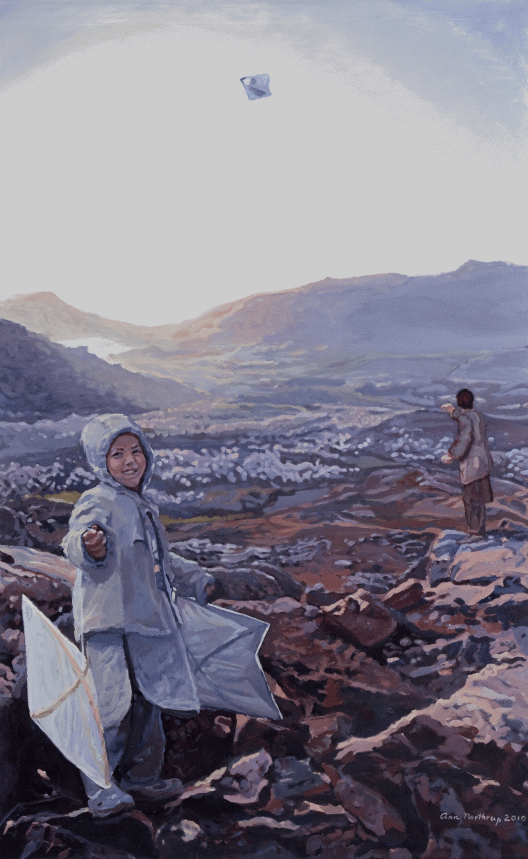
“Mountain Kites” by Ann Northrup; photo by AFSC.
To say one has a favorite painting in such an exhibit may seem odd, but it’s our nature to make such distinctions, even here. Heather’s is Ann Northrup’s Mountain Kites, perhaps the most serene and hopeful in the gallery. Joyful children flying kites in an open field—an idyllic vision filled with possibilities. In contrast to the other panels, it seduces rather than shocks. In the foreground of a florid mountain valley, a child bundled in parka and hood smiles and clutches a kite, ready to launch it into the wind. Close by, her father has already set one afloat. The scene’s tensions are themselves at odds. One derives from a simple and pleasing action about to unfold. The girl smiles broadly as if we’d asked her to pose for a snapshot before she scampers away to release her kite. This scene might as easily be set in Colorado or Spain or China or anywhere children fly kites. But context matters, and here, surrounded by the tragedies of this war depicted in the nearby panels, we’re compelled to imagine the prospect of bombs suddenly falling on this scene too, even as we perceive history’s road not taken, or yet to be taken, or taken still, despite the war. The artist writes, “I wanted an image that people could identify with, a child that they could fall in love with and that they would want to cherish and protect.”
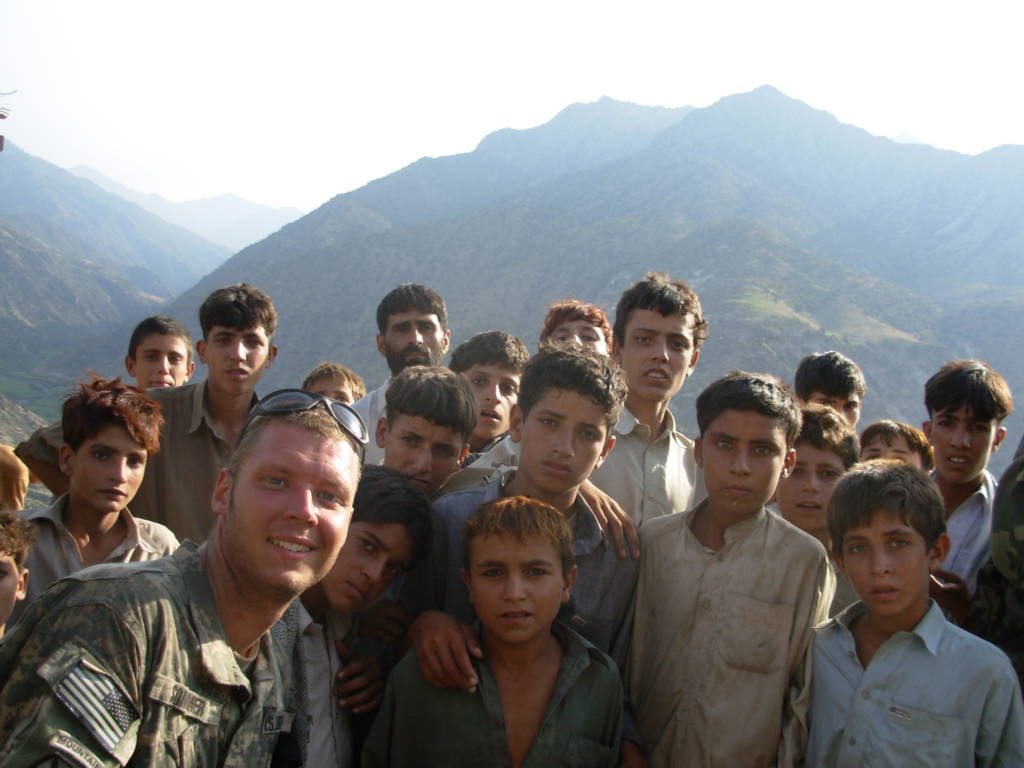
Photo by Jon Demler, circa 2007
This is Francis surrounded by Afghan children—all boys, but for one bearded man in the background. Girls would not be allowed to venture out among soldiers like this. Some of these boys worked at the outpost, cleaning and doing chores. This photo was probably taken in 2007. Francis had grown wary of children in Iraq, but he always had a weakness for them and said he liked some of these kids. They’d be in their twenties now. I keep this photo on my desk and sometimes wonder what became of them, whether they joined the Taliban or Afghan National Army, or even survived the war.
In most of these paintings we view Afghanistan as observers, but in Lillian Moats’s Collateral Damage, we become aggressors as we peer through the crosshairs of a riflescope and watch mortar rounds explode. Plumes of smoke fill the background, while close up, like a TV picture-in-a-picture, a girl watches through a window, sitting perhaps as she was in the moment before the bombs struck. Western eyes cannot avoid associating her sky-blue robe and white headscarf with traditional images of the Virgin Mother as she appears in church windows and on Hallmark greeting cards. How would it be possible for a young Middle Eastern woman of two millennia ago to have the features and clear, pink skin of a Caucasian cover girl? Whomever the emblematic girl in Collateral Damage resembles, or doesn’t, she is already dead by the time we see her in this painting. The white glow that fills her window will consume her in the next moment.
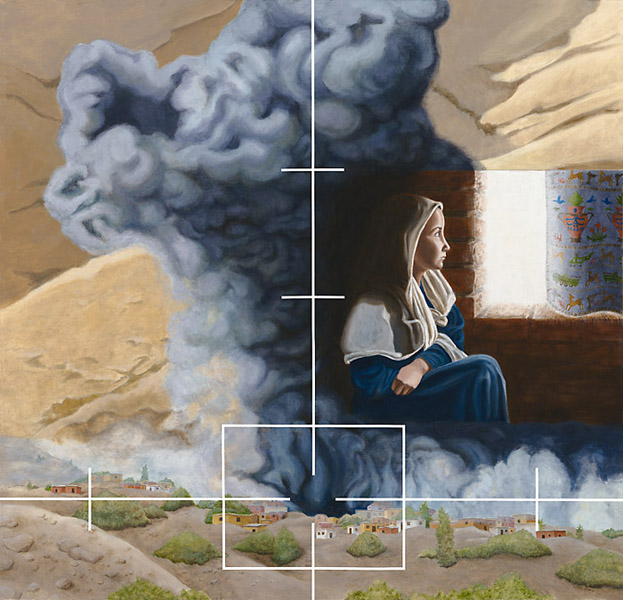
“Collateral Damage,” oil painting by Lillian Moats, photo reference: Paul Jeffrey of ACT; image courtesy of the artist.
*
I have suggested until now that we, Heather and I, looked through these paintings as if they were windows with a view of the Afghanistan war’s victims, and that to the extent these images were mirrors, the reflections we saw, like Hawthorne’s Hester Prynne spying the ominous figure of Chillingworth in the mirror behind her, were those of the culture that surrounds us. But what of us? What did we see of ourselves?
It is true that grief for the loss of a child knows no comparisons, that losing a child is as tragic for the wealthiest parent on the planet as it is for the poorest, but this is an unfair dodge. The people depicted here are victims of a kind of menace that bears no semblance to how my son died. In a large sense, we may all be victims of these wars, but the analogy breaks down when bombs start falling on your home. I suggested earlier in that the child with his prosthetic leg in Learning to Walk Again would have seen in Heather and me unimaginable wealth and abundance, no matter the reality of our means, for whatever those means are we live in a more fortunate world than he. Our complicity is rooted in that world. We must acknowledge that Francis was part of the invading force and that we watched for news of him and his friends eagerly, while foreign casualties were also part of the background in such moments. Surely, this is natural. And surely, too, just recognizing our complicity was not enough.
He died a civilian, a veteran, in early 2011, as the Fukushima nuclear disaster devastated the lives of more than a hundred thousand people in Japan and as the Arab Spring was unfolding across the Middle East. The climate of chaos from these and other events that year gave us near-daily reminders that as we grieved in our own way and time, sharing that grief with family and friends, and still sleeping (the little that we slept) in our own beds and eating (the little that we ate) as we needed, many others did not have such comforts as they faced tragedy. Our grief was blinding, stifling, breathtaking, but it had few distractions. Poet David Ray portrays a similar contrast of worlds in his sonnet “Bhopal,” from Sam’s Book, an extended elegy for his own son who died at age eighteen in 1984, the same year that gas poisoning from Union Carbide’s pesticide plant killed tens of thousands in Bhopal, India. The proximity of Ray’s loss to that event—and distance from it—is depicted through the experience of Bhopal families who’ve even been deprived of the chance to mourn properly:
… no time
for weeping as when we lost our son Sam
and stood, hands joined, to wish him well in some
life beyond.6
They are, he adds, victims twice over because their brownness renders the deaths of their loved ones of lesser consequence in the First World, which is, of course, the source of their suffering:
One thing that’s certain though is this: Third World
or one beyond, they’re all our children now,
though borne by millions in brown arms and black,
and not much mourned by those who think their own
are wonders, others somehow less.7
So there was complicity in our reflections, even if unintended. Was it fair to bring our grief here, to infuse the tragedies depicted in these panels with our own sorrow? This was more than a Sunday afternoon at the museum for us. More of a pilgrimage. Though, in retrospect, those gallery visitors who had no such loss to drive them here and still came, the few who did, may deserve more credit. Still, intent may not be enough. Privilege resides in a failure of recognition even more than the conditions of a life.
As of this writing, it has been six years since we experienced Windows and Mirrors. The website for the exhibit has since been removed. As we walked through the halls of the library that day, it was already evident that the war in Afghanistan would surpass Vietnam as America’s longest war. It is now becoming America’s endless war. According to a Brown University study, over 31,000 Afghan civilians have been killed since the American invasion in 2001, a number that, as stunning as it is, doesn’t remotely approach the immeasurable devastation for hundreds of thousands of survivors of the violence there.8 American losses in Afghanistan number over 2,200, with over 20,000 injured. President Barack Obama committed some 8,400 troops to remain in Afghanistan when he left office. His successor recently spoke of plans to add 5,000 more so America could “starting winning” again in Afghanistan, whatever that means.9
And still, the imagery from Windows and Mirrors remains with us in both imagination and fact. Heather displays a poster of Mountain Kites in her classroom. We keep pictures of two Afghan children from the exhibit on a shelf in our living room near a photo of Francis. If we came away with anything that day, it was finally the recognition that our son’s death is one tragic speck in the vast tapestry of our wars, and that the victims, including Francis, are “all our children now.”
Footnotes
[1] Rita Pomade, “Mexican muralists: the big three – Orozco, Rivera, Siqueiros,” MexConnect website: http://www.mexconnect.com/articles/1064-mexican-muralists-the-big-three-orozco-rivera-siqueiros.
[2] Kari Lydersen, “Afghanistan,” New York Times, July 1, 2011, web: http://www.nytimes.com/2011/07/01/us/01cncmurals.html
[3] Theodor W. Adorno, Aesthetic Theory, trans. Robert Hullot-Kentor (London & New York: Bloomsbury, 1997), p. 7.
[4] Rory Carroll, “Bloody evidence of US blunder,” The Guardian, Jan. 6, 2002. Web: https://www.theguardian.com/world/2002/jan/07/afghanistan.rorycarroll. See also: https://ratical.org/ratville/CAH/civiDeaths.html; https://www.theguardian.com/world/2003/feb/13/afghanistan.rorymccarthy; http://www.tomdispatch.com/post/174954/engelhardt_the_wedding_crashers.
[5] Andrew J. Bacevich, The Limits of Power: The End of American Exceptionalism (New York: Henry Holt & Co., 2008), p. 62.
[6] David Ray, “Bhopal,” Sam’s Book (Middletown, Conn.: Wesleyan UP, 1987), p. 72.
[7] A recent example: following the May 22, 2017, terrorist bombing in Manchester, England, images and stories of the attack’s 22 victims received exhaustive coverage; less than two weeks later a massive bombing in Kabul, Afghanistan, that killed 90 people and injured over 450 was treated like a back-page story in most news outlets. See Amy Goodman and Denis Moynihan, “A Kabul Bomb Blast Has Killed at Least 90 People. We Need to Know Their Names,” Democracy Now!, June 1, 2017, web: https://www.democracynow.org/2017/6/1/kabul_bomb_blast_kills_at_least.
[8] “Afghan Civilians,” Costs of War (Watson Institute of International and Public Affairs). Web: http://watson.brown.edu/costsofwar/costs/human/civilians/afghan
[9] Paul Szoldra, “What are we even doing in Afghanistan?” Business Insider, May 9, 2017. Web: http://www.businessinsider.com/president-trump-afghanistan-war-troop-surge-2017-5
References
Artworks described in this essay:
- Asher, Rikki. Bamiyan Buddha and Weeping Women.
- Hazelwood, Art and Juan Fuentes. Airstrikes on Weddings.
- Moats, Lillian. Collateral Damage.
- Munguia, Jessica. Untitled.
- Northrup, Ann. Mountain Kites.
- Tanier, Nanna. Salema.
- Weber, John Pitman. Learning to Walk Again.
Further background on the exhibit may be found at these websites:
“Art vs. War – American Friends Service Committee’s Windows and Mirrors.”
YouTube: https://www.youtube.com/watch?v=dQ7z0G65eCs.
“Deadly Embrace: The War in Afghanistan,” Afghanistan 101, May 4, 2011. Web:
afghanistan101.blogspot.com/2011/05/deadly-embrace-war-in-afghanistan.html.
Windows and Mirrors: The War in Afghanistan. Web: http://afsc.org/story/windows-and-mirrors-war-afghanistan.
Robert F. Sommer is the author of Where the Wind Blew (Wessex, 2008) and A Great Fullness (Fomite, 2016). His essay, “The Art of Grief: ‘Windows and Mirrors,’” is adapted from a work-in-progress entitled Losing Francis: One Family’s Journey through a Decade of American War. Excerpts have also appeared in Rathalla Review, New Plains Review, O-Dark-Thirty, Emrys Journal, Red Earth Review, and The Whirlybird Anthology of Kansas City Writers. Sommer is the Director of Development for the Sierra Club in Kansas and a lecturer at the University of Saint Mary, Leavenworth. His blog is Uncommon Hours. To learn more about Francis, please visit FrancisFund.org.



